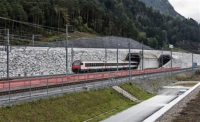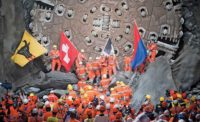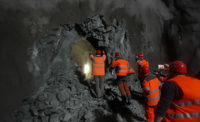Robotic Inspection Checks Out Tunnel in the Alps Set to Become Rail Link
Custom-built rover scans exploratory tunnel for potential hazardous conditions

Photo Courtesy Webuild S.p.A.
Before converting a five-year-old exploratory tunnel on the new Turin-Lyons rail link into part of the main Alpine drive, Italian engineers had to assess its condition after lying idle for five years in a potentially hazardous environment.
Working with contractor Webuild Group, CIM4.0, a public-private partnership competence center, developed a wheeled, battery-powered robotic rover that can sample ambient gases and probe conditions in the last 3 km of the 7.6 km Maddalena pilot at Chiomonte, some 60 km west of Turin, Italy.
The robot has a 10-km maximum range, and can be operated from up to 2 km away from its controller. Able to detect a range of gases, the 3.5-m long, 1.8-m tall robot is equipped with cameras, sensors and antennae. It can cross 20-cm high obstacles and 30-cm deep water while operating in temperatures up to 45°C (113°F) and 80% humidity, according to Webuild.
The contractor is excavating 22 niches 4.5 m into the pilot's side to allow construction traffic. Never intended to serve as the main tunnel, the 6.3-m-dia pilot tunnel is too narrow for two-way traffic. The original plan was to start the main drive at Susa, Italy, about 7 km away.
The 270-km, high-speed Turin-Lyons railroad will cross the Alps in the 57.5 km Mont Cenis base tunnel, which is set for completion in 2030.







